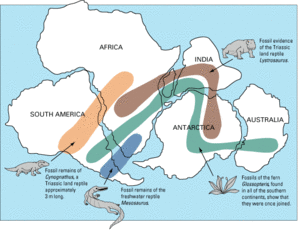Continental Drift
History Of Wegener's Theory, Evidence Of The Theory, Formation Of Pangaea, Pangaea Splits

The relative movement of the continents is explained by modern theories of plate tectonics. The relative movement of continents is explained by the movement
Diagram illustrating formation of continental margins. (a) Materials in Earth's mantle move up (often through volcanos) expanding the continental crust and causing rifting. (b) As it divides, the continental crust thins, and continues to separate. (c) New oceanic crust forms from the mantle materials that have surfaced. (d) The oceanic crust is further widened by sea floor spreading.
Explanations of continental drift that persisted well into the twentieth century made the improbable geophysical assertion that the continents moved through and across an underlying oceanic crust much as ice floats and drifts through water. Eventually multiple lines of evidence allowed modern tectonic theory to replace continental drift theory.
In the 1920s, German geophysicist Alfred Wegener's writings advanced the hypothesis of continental drift depicting the movement of continents through an under-lying oceanic crust.
Wegner's hypothesis met with wide skepticism but found support and development in the work and writings of South African geologist Alexander Du Toit who discovered a similarity in the fossils found on the coasts of Africa and South America that were seemingly derived from a common source. Other scientists also attempted to explain orogeny (mountain building) as resulting from Wegner's continental drift.
Technological advances necessitated by the Second World War made possible the accumulation of significant evidence regarding Wegener's hypothesis, eventually refining and supplanting Wegner's theory of continental drift with modern plate tectonic theory. Although Wegener's theory accounted for much of the then existing geological evidence, Wegener's hypothesis was specifically unable to provide a verifiable or satisfying mechanism by which continents—with all of their bulk and drag—could move over an underlying mantle that was solid enough in composition to be able to reflect seismic S-waves.
Additional topics
- Continental Margin - Continental Shelf, The Continental Slope, Submarine Canyons, The Continental Rise
- Continental Drift - History Of Wegener's Theory
- Continental Drift - Evidence Of The Theory
- Continental Drift - Formation Of Pangaea
- Continental Drift - Pangaea Splits
- Other Free Encyclopedias
Science EncyclopediaScience & Philosophy: Condensation to Cosh